This research was originally delivered as a paper at the European Australian Studies Association annual conference, Toulouse 1999. Conference convenor Xavier Pons drew together speakers on Patrick White, Murray Bail, larrikin movies of the 1970s and a remarkable range of other topics from European scholars. I’ve taken the opportunity here to correct a few minor errors in the published texts and to add some illustrations.
Australian culture’s transition from modernism to postmodernism has been long and complex, and will continue to be so. While such epochal transitions are often identified as a distinct temporal break, stylistic revolution or aesthetic rupture, I prefer to consider the transition in terms of Raymond Williams’s gradualist model of the residual and emergent in culture. 1 From the mid-1970s, slowly and unevenly, modernist figures have waned while postmodern effects have become more prominent. But it is not in the displacement of one by the other that we will find the keynotes of recent Australian history; these lie instead in the contradictions arising out of their concurrence.
I would like to use Australian popular music to explore this passage from one, familiar and still challenging, way of conceiving of culture and politics to another, newer, but not unfamiliar, one. Three bands—News, Boys Next Door and the Slugfuckers—were each associated with punk rock over the period 1977–1981. 2 Each band attended to the confluence of music, politics, culture and image in ways that embodied a shift from modernist to postmodernist models of agency, intervention and resistance. Broadly speaking, the activities of these bands signal a movement away from politics conceived in the classical terms of instrumental power, organized parties, and class struggle towards politics conceived in terms of polysemy, textuality and subcultural identity. Such a movement might, equally broadly, be seen as a shift from the smoke-stack economy of modernism to the information economy of postmodernism, from a politics of materiality to a politics of semiosis, from an identity anchored in class to one adrift in the mutable fields of lifestyle
My account of this transition begins around 1975, a point Meaghan Morris identifies as inaugurating ‘a greater uncertainty, [and] instability in our understanding of the relations between “culture” and “politics”’. 3 In the pluralist aftermath of student activism and the anti-Vietnam War movements, culture and politics could not be separated as cleanly as they might have been earlier into realms of the aesthetic and the practical, the abstract and the real, the aristocratic and the everyday. New challenges came in the form of questions that melded previously separable domains. How was politics enacted in, or effected by, culture? Where was politics enacted in culture: in the academy? in art? on the street? Who enacted politics: classes? political parties? genders? races? subcultures?
The guerrillas: News
The Melbourne punk band News emerged in circumstances typical of the ‘classical political activism’ that Morris identifies as declining after 1975. Their first single, ‘Dirty lies’, released in May 1978, had all the hallmarks of what has been called social-realist punk: simple, urgent rock rhythms, and forthright lyrics addressing current social issues. Wearing everyday clothes, rather than the elaborate costumes of pop bands, and supported by a graffiti campaign that saw their name spray-painted around inner-city streets, the News could be regarded as an example of what the Australian music press termed a ‘street punk’ band; that is, a young, independent band, with attitude, seeking a return to the authentic roots of rock’n’roll. 4
Like the music, the sleeve art for the ‘Dirty lies’ single was deliberately unrefined. Individual sleeves were hand-stencilled with a lurid yellow-green fluorescent title. On the label, visible through the central cut-out of the sleeve, was the international symbol for radioactivity. These blotchy irregular markings sought a raw, expressionistic graphic effect, in opposition to the slick marketing devices of mainstream recordings In this respect, the single, as a visual artefact, already signalled the simultaneous presence of the modern and the postmodern. Street punk demanded a return to a version of modernism already being overtaken by the image economy of postmodernism, the street punk graphics sought to resist the already evident turn towards a culture of manipulated and mediated styles and surfaces.
The song ‘Dirty lies’ itself exemplified the modernist politics of the band. In Morris’s terms, the band saw politics as something ‘acquired from the various social movements … and then brought to bear on one’s media work’. 5 The radioactivity symbol on the sleeve was coupled with a direct address of the Cold War and the politics of uranium mining in the lyrics of the song. In ‘Dirty lies’, sneering vocals and a declarative delivery made the song both an. accusation and a manifesto:
Dirty lies, dirty lies
I don’t want your dirty lies no more
No I don’t want your rule to become the law
What they want is stealing from the poor
I don’t want the world that’s on TV,
I don t want uranium to kill
I don’t want plutonium should spill
This was a voice that would identify lies, as a prelude to delivering the truth. As if to reinforce this, the roneoed lyric sheet was reminiscent of an underground broadside, As one band member put it, ‘We had a statement to make and were a directly anti-establishment punk band’. 6
The establishment that the band opposed was faceless and totalitarian. It was the enemy against which News defined itself, unabashedly and unusually as ‘a left wing band, a Socialist band’. 7 ‘They’—the establishment, stole from the poor, degraded the environment, and risked nuclear holocaust, out of greed. This was the enemy of the classic late-modernist radical, the inner-city leftist of the 1970s. The politics of the band were articulated around the issues that dominated post-Vietnam War agitation, particularly uranium mining and nuclear disarmament. The middle eight of ‘Dirty lies’ delivered a spoken warning;
Newsflash
The USSR has just bombed the USA
No survivors are expected
We suggest you leave the city immediately
News’s vision was of a world governed by Cold War and class politics, threatening an imminent Armageddon. The song was written in the immediate aftermath of the Fox Inquiry into uranium mining. Initiated by the Whitlam Labor government in 1975, and completed under the Fraser Coalition administration, the Fox Inquiry lodged two reports, in 1976 and 1977. These focused debate on the economics and ethics of nuclear mining, emphasizing the global and environmental effects of nuclear power and arms. While the inquiry considered evidence regarding the impact of mining on the environment and on the rights of indigenous landowners, its pragmatic conclusion was that limited exploitation of uranium deposits would give Australia sufficient economic and moral leverage to encourage the responsible development of nuclear power globally. Since the Liberal-National Party Coalition and the Australian Labor Party both accepted such logic, it could be argued that the issue of uranium mining encouraged disillusionment with the electoral process as a means of reform, accelerating a shift away from the politics of parties towards the politics of issues and activism that had begun during the Vietnam War
News responded to the politics of environmentalism, disarmament, and land rights in modernist terms. Seen as a conflict between the radical Left and capital, politics were articulated in terms of the struggle for truth, advocacy on behalf of the poor; concern for the environment, resistance to the wealthy, and suspicion of the mass media. News embodied Morris’s reading of the conventional relationship of politics with culture, in which it was ‘a matter of taking politics to various cultural activities’. 8 That is, the ways in which News made music did not change to any great degree from rock’s norms. If their music and visual style differed at all, it was in their desire to return to an earlier version of rock’n’roll, rather than inventing a new one.
As a performance, ‘Dirty lies’ sought to combine information and emotion, with the latter sustaining and underscoring the former. Lyrical denotation was the primary bearer of meaning, ably supported by the rhetorical connotations of musical style News assumed that communication could be as direct and clear as the naming of iniquity in lyrical form; their stated ambition was to say to an audience, ‘Look how you are being wronged’. Hearing the song, an audience would ‘realize what’s wrong with capitalism’; this, the band claimed, was the first step towards socialism. 9
All of this is typical of the social-realist stream within punk, It epitomizes the interpretation—popular on the Left—that punk was born of working-class politics, youth unemployment and urban decay. 10 This was a simplistic account of punk’s impetus but one that offered the promise of the rediscovery of class-based political consciousness within youth culture. But while there is no denying the very real hardships of unemployed youth during the recession of the late 1970s and 1980s, class politics was only one element of their response to their circumstances. Many of the more prominent punk bands used the indirect strategies of infiltration, mimicry and irony rather than the direct opposition anticipated by classical politics. 11 ‘Dirty lies’ is symptomatic of Australian politics on the cusp of the modern and the postmodern: modern in its structuring of politics in terms of capital, class and power; postmodern in its structuring of political activism around environmentalism and land rights.
The poseurs: Boys Next Door
Also performing in Melbourne at this time was a band whose very name—the Boys Next Door—suggested suburban normalcy, in contrast to the inner-city radicalism of News. While the Boys Next Door played in inner-city venues and dabbled in the petty criminality of the bohemian, they displayed no overtly political views. Theirs was a practice founded in different forms of resistance, gleaned from literature and art.
In contrast to the ‘street’ ethos of News, The Boys Next Door developed a highly self-conscious musical and performative style. This style derived in part from musical models, especially David Bowie, who had reveled in the theatrical power of rock, admitting that he had ‘helped establish that Rock and Roll is a pose’, before dismissing it as ‘a toothless old woman’. 12 Equally important was the art school experience of singer Nick Cave and guitarist Roland Howard. Here the subjective, personalized and poetic versions of politics on offer in avant-garde art were still prized. In both popular culture and art, then, the Boys Next Door found an avant-garde practice privileging irony and experimentation. Its hallmarks were mannered, even foppish, effects in lyrics and performance, and angular, counter-melodic compositions. Artist and musician, Philip Brophy described Cave as ‘a posture of the real’, whose performance simulated emotion. 13 In this sense, the Boys Next Door could be said to be deconstructing—in the non-technical sense of that term—rock’s conventions, enacting the figure of the romantic rock-poet with sufficient irony to deflate it.
The band’s predilection for irony was articulated on stage in alternately deadpan and bombastic performances deliberately teetering between pathos and bathos. Comparing his paintings with his music, Cave claimed that ‘What they mean is something incredibly dry but the way they’re painted is really flamboyant , a dry sort of statement but the images are really potent’. 14 Dry and flamboyant might also describe the band’s visual presentation in publicity photos: a casually disdainful address to the camera was punctuated by an artfully skewed limb; simple jeans and plain shirts were embellished with painted musical notes. In such images, the band sought to bridge the stage and the street, the harlequin and the hustler, the poet and the performer.
While ironic simulation has come to be seen as a central characteristic of postmodernism, it would be wrong to distinguish the Boys Next Door from modernism too clearly. Like News, they straddled both modernism and postmodernism. The Boys Next Door melded claims to both authenticity and artifice in their work. Nick Cave characterized the band’s songs as ‘kind of sad and tragic but they’re treated with a sort of sarcasm’. 15 Roland Howard claimed that the band had ‘a self-mocking attitude about everything.’ 16 If anything, their postmodernism was of the hybrid form: ‘both–and’ rather than ‘either–or’. 17 The Boys Next Door’s art school posturing was of the classical modernist kind: masculinist, subjective, independent and given to expression in iconoclastic gestures of inversion and transgression. 18
Like News, Boys Next Doors saw their music as having a cognitive effect, but not in the direct, instrumental sense of the former. Howard claimed, ‘We are trying to provoke people into thinking, disturbing their ideas of what things are, and reorientate themselves, because the people just accept things mindlessly’.19 This desire fordefamiliarization—the ‘making-strange’ of Russian formalist theory—was then a standard tactic of the artistic, theatrical and cinematic avant-garde. Music could have a cognitive effect, but not one based on a literal message. Cognition was born of conceptual instability; this was a politics of effects, not of information.
The Boys Next Door’s version of resistance, then, was theatrical rather than informational, rhetorical rather than declarative, effected through style and sign rather than directly signified. This is exemplified in the band’s signature tune, ‘Shivers’, written by Roland Howard and recorded by Boys Next Door in January 1979:
I’ve been contemplating suicide
But it really doesn’t suit my style
So I think I’ll just act bored instead
And contain the blood I would have shed
Recorded with the instrumentation of a lyrical ballad, the song opens with piano chords sonorous to the point of being ponderous. It is sung in a breathy, nasal style worthy of a crooner, but equally conveying the narcissistic self-pity of teen angst. If News sought emotion, Boys Next Door delivered it in spades but with their tongues firmly in their cheeks.
This play of sincerity and irony, authenticity and artifice, was central to the punk scene in Melbourne. The artists, actors and students who formed its backbone rediscovered the transgressive power of style. Narrow ties, winkle picker shoes, fish net stockings and, above all, black clothing performed the double function of identifying a subculture while offending parent or straight culture. In his Men in Black (Reaktion, London, 1995), John Harvey traces the many meanings of black clothing, several of which seem to have been combined in the art-punk scene: romantic melancholia and morbidity associated with Romanticism; the evocation of the status of a uniformed elite; a sense of power, derived from black’s clerical or military lineage; and the association of black leather with transgressive subcultures such as bikers or S&M practitioners.
With typical irony, Roland Howard suggested that the Boys Next Door took an interest in punk because they ‘liked the pictures [in New Musical Express]’. 20 This was the politics of style—seen as so superficial by the classical Left—that was to propel Australian vanguard culture into the 1980s. With it came new, more mobile forms of identity, agency and resistance. Politics longer amounted to naming issues, pursuing campaigns, or identifying evil. Instead, politics was enacted as specialized forms of consumption and performance, establishing identity and status within quasi-professional subcultural groupings. In this regard, it is significant that punk’s politics of style had its most significant impact on the cultural professions: theatre, music, art, film, journalism.
The Boys Next Door’s success in galvanizing significant numbers of young culture makers around a set of consistent yet contradictory values—such as vanguardism, vitalism and stylish irony—marked a shift from class to lifestyle politics. Anthony Giddens has defined lifestyle as ‘a more or less integrated set of values, attitudes and actions which an individual embraces, not only because it constitutes a foundation for material practices, but because it gives material form to a particular narrative of self-identity’. 21 Significantly, ‘lifestyles mediate between material and social conditions, on the one hand, and popular cultural products produced within consumer culture, on the other’. .22 That is, lifestyle allows culture to be experienced as imbrication rather than distinction, to be understood in terms of incorporation rather than opposition. This is, in short, the difference between the modernist either–or, and the postmodernist both–and.
The nomads: Slugfuckers
This shift from a classical politics of the left to a new politics of mobility and intensity was systematically developed by Sydney band, the Slugfuckers between 1979 and 1981. Described as the nadir of Australian punk, the band was formed by philosophy and art students from the Universities of Sydney and New South Wales, and the Sydney College of the Arts (SCA). Associated with the early development of industrial music, the band might more accurately be considered a project or platform, combining theoretical writing, performance, graphic design, video and music.
Underpinning these practices was an explicit theoretical program; the rejection of the Althusserian leftism then prevalent in Sydney radical circles in favour of the post-Enlightenment anarchism of Paul Feyerabend and the schizo-analysis of Deleuze and Guattari. Cognito, the journal of the University of New South Wales Socratic Society, was, in 1979, effectively the band’s publication.

Slugfuckers, Instant classic, ‘Deaf disco’ c/w ‘Deaf dub’, 45 rpm single, 1978, silkscreen on fanfold computer paper
The cover of Cognito number 3 was designed by John Young, a recent philosophy graduate who had commenced study at the SCA. The central image was a graphic demolition of Descartes; the familiar features of the French philosopher were split apart, becoming a grotesquely decayed cadaver. Young also edited Z/X, the SCA journal, and made it a platform for the Slugfuckers. Articles in Cognito melded the lyrics of the Sex Pistols and other punk bands with post-1968 theory and philosophy. Vocalist Terry Blake insisted that ‘decenteredness, plurality, proliferation, process, difference and de-Oedipalization’ would end the ‘Althusserian hegemony’. 23The narrow instrumentalism of existing revolutionary theory would be replaced by schizo-revolution. Feyerabend, Foucault, Deleuze and Guattari, Kristeva and the Sex Pistols were all ‘on the side of process, flow, multiple arrangements, of multiplying and intensifying thought and action’. 24 Visually, these ambitions were embodied in layered, neo-Dada collages, such as those that guitarist John Laidler, Slugfuckers’s guitarist, contributed to the journal, or in the fragmented texts slipped inside the sleeves of the bands recordings.
These are all effects sought in the layered, improvised, shambolic recordings of the group. Laidler summed up the Slugfuckers’s project in terms that melded the rhetoric of schizo-analysis with science fiction. Society was a ‘mechanical social system, essentially aloof and unaccommodating to the flows of desire. Society as the great pretender, the super android, the Walking Dead. We are schizophrenics trapped into being zombies. Punk is the irruption of us as schizos in the midst of us as zombies.’ 25 The Slugfuckers’s demands—declared in their song ‘Schizo-revolution’—have all the hallmarks of the reconfigured politics of the post-1968 epoch: a refusal of the corporate politics of Left and Right; insistence on subjective, over objective, politics; a preference for spontaneity over organization; use of cultural, especially theatrical, forms of communication; political action developed on the basis of social, or subcultural, identity:26
I don’t like your revolution
Seems to me like devolution
I don t think it’s my solution
Just another mind pollution
Chorus: Your revolution is a lump of shit, my revolution is a cosmic fit
Your revolution :s painted red
Mine’s a thousand volts right through the head
But it was not enough simply to set Deleuze and Guattari to music. Schizo-analytical texts were to be presented as a cacophonous layering of rhythm, slides, videos, costumes, at a volume so loud that panes of glass were literally shaken from window frames. The success of such a performance was not to be measured on aesthetic grounds but on the extent to which it acted as an irrational irruption. As one reviewer put it, ‘they made the police come to the campus so they must be great, better than old folkies’. 27
Clearly the orthodox criteria of music criticism do not apply here. But at the level of cultural politics, the Slugfuckers did contribute to a significant success: a shift in the conceptualization of the politics of identity whose trajectory will propel Australian culture into the next century; a shift away from empiricism towards semiosis as the register of Australian experience; a shift away from Australian identity as something to be named or located, towards an identity that is collaged, layered and performed. The ‘Althusserian hegemony’ has indeed passed, as has the demand for an identity framed in terms of singularity, linearity and cohesiveness
The passage from News to Boys Next Door to the Slugfuckers is a passage from a politics of class identity towards a postmodern modelof cultural identity. Identities embodied, through performance and style are not without their systems but tend to be constructed as temporal, even temporary, effects, rather than being recognized as symptoms of deeper; material points of anchorage. And it is here that the politics of art and punk in the late 1970s can be distinguished from those of a slightly earlier period. I am not suggesting that there was a sudden or marked change in the ways that politics were articulated. Debate on the ideologies and activities of the Australian New Left had already signalled a departure from a Left politics classically conceived in terms of Marxism and class struggle. Theorists of the New Left had in fact proposed strategies that punk subcultures would later develop further. In particular, the concept of ‘enclave culture’—exemplary forms of social organization that were not ‘distinctly political’—bore a family resemblance to the later subcultural activities of the punk scene. 28 And artists were already familiar with such a model, given that bohemia was one of the great, historically ratified forms of enclave culture. However, if the New Left saw a need to leave behind a politics that ‘speaks only in terms of institutions, organizations, meetings, mobilizations, pragmatic necessities, power contestations and the relations and forces of production’ 29 it was also wary of the two key ingredients of a project such as that of the Slugfuckers: popular culture and desire. All the temptations of mass culture—its intensity, its supposed superficiality, its cornmodification—were precisely what appealed to the art–punk enclave of the late 1970s. The mutability of fashion, the mannered effects of the publicity photograph, the fleeting intensities of the pop song, the aleatory quality of performance—all brought with them the traumas of a mobilized, momentary or ungrounded subjectivity. The visual and musical style of punk celebrated, rather than resolved, that trauma, setting the tone for Australian experience in the 1980s and 1990s.
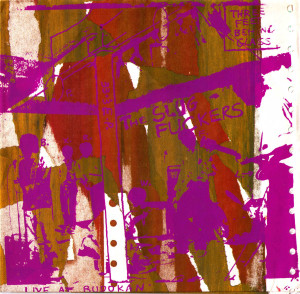
Slugfuckers, Three feet behind glass: live at Budokan, 33 1/3 rpm EP (7 inches), 1980. Silkscreen on fanfold computer paper
Research for this paper was undertaken with support from the Australian Research Council grants scheme. Research assistance was provided by Jolanta Nowak. Interviews, information and access to recordings and publications was generously provided by Graham Forsyth, John Laidler, John Young, Henry Weld and by the staff of Silver Rocket, Phantom and Au Go Go record stores.
Original publication: in Xavier Pons (ed), Departures: how Australia reinvents itself, Melbourne University Press, Carlton South, 2002, pp. 192–201.
- Raymond Williams quoted in Fredric Jameson, ‘Postmodernism; or the cultural Logic of late capitalism’, New Left Review, no 146, July–August 1984, p 57. ↩
- For a general survey of Australian independent music in this period, see Clinton Walker, Stranded, Pan Macmillan, Sydney, 1996. ↩
- Meaghan Morris, ‘Politics now’ in her The pirate’s fiancée, Verso, London, 1988,p 174. ↩
- For definitions of ‘street punk’, see Anon, ‘Letters’, RAM, no. 24, 30 January 1976, p. 30; Anthony O’Grady, ‘AC/DC: Australia has punk rocks bands too y’know’, RAM, no 4, 19 April 1975, pp 11 & 15; Anthony O’Grady, ‘The death of punk rock’, RAM, no. 28, 26 March 1976, pp 22 & 36; Anon, ‘RAM street punk colours: Wear ’em with pride’, RAM, no 26, 27 February 1976, p 9. A similar discussion of the street punk retrieval of roots rock was conducted in the English music press at this time. ↩
- Morris, ‘Politics now’, p 176. ↩
- David Langsam. ‘Here is the News’, Juke, 30 June 1979, p 13. ↩
- Langsam. ‘Here is the News’, p 13. ↩
- Morris, ‘Politics now’, p 176. ↩
- Langsam. ‘Here is the News’, p 13. ↩
- The classic articulation of this thesis is Peter Marsh, Dole queue rock’, New Society, 20 January 1977, pp. 112-14. An Australian version appears in Keith Windschuttle, Unemployment, Penguin, Ringwood, 1979. It was a vision of punk also popular in leftist student newspapers such as Monash University’s Lot’s Wife. ↩
- See, for example, accounts of punk’s symbolic and tactical forms of resistance in Dick Hebdige, Subculture: the meaning of style, Methuen, London, 1978 and Kenneth J Bindas, ‘The future is unwritten: the Clash, punk and America, 1977-1982, American Studies, vol 34, no 1, Spring 1993, pp 69–89. ↩
- Mike Drayson and Anthony. O’Grady, ‘David Bowie interview’, RAM, 26 July 1975, no 11, p 19. ↩
- Philip Brophy, ‘Visions of reality’, Stuff, 4 December 1984, not paginated. For a discussion of a specific Boys Next Door performance, see Chris McAuliffe, ‘Let’s talk about art: art and punk in Melbourne’, Art and Australia, vol 34, no 4, 1997, pp 502-12. ↩
- Anon, ‘Boys Next Door: alien tales’, Juke, 15 July 1978, p 13. Cave’s biographer notes his fascination with Brett Whiteley as an art student in Ian Johnston, Bad Seed, Little Brown, London, 1995,pp 24 & 39. In interviews. Cave has expressed interest in the work of Chaim Soutine, Mathias Grunewald, Francis Bacon, Lucian Freud and Giorgio de Chirico. ↩
- Jillian Burt, ‘Boys Next Door’, Roadrunner, vol 1, no 3, June 1978, p 6. ↩
- John Stapleton, ‘The Boys Next Door’, Roadrunner,not dated (probably December1979). ↩
- American architect Robert Venturi proposed this distinction in his Complexity and contradiction in architecture, Museum of Modern Art, New York, 1977. ↩
- For discussion of the agonistic impulse in the modernist avant-garde Renato Poggioli, The Theory of the avant-garde, Harvard University Press, Cambridge MA, 1968. Simon Frith and Howard Horne, in Art into pop, Methuen, London, 1987, discuss at length the persistence of modernist models of the avant-garde in the art school breeding grounds of English punk. ↩
- Vicki Riley, ‘Nick and Roland tell party jokes’, Vox Muzpaper, no 1, 12 February 1981, p. 7. ↩
- Tim Aanstedt, ‘The Birthday Party interview’, Offense Newsletter, April 1983. ↩
- Anthony Giddens, Modernity and self-identity, Polity, Cambridge, 1991, p 81. ↩
- Thomas Johansonn, ‘Late modernity, consumer cultures and lifestyles: towards a cognitive-affective theory’, in Karl Erik Rosengren (ed), Media effects and beyond : culture, socialization and lifestyles, Routledge, London, 1994, p 270. ↩
- Terry Blake, ‘The dis-corpse of Althusser. a paranoiac fantasy’, Cognito, no 3, 1979, no pagination. A detailed account of the epistemological controversies raging in Sydney at this time can be found in a text by Graham Forsyth (Slugfucker and editor of Cognito), ‘The enchantment of theory or science, speculation and subjectivity: the vicissitudes of theory in Sydney 1973-84’, in John Young, John Young : silhouettes and polychromes 1979-1992, Schwartz City, Melbourne, 1993, pp 47-66. ↩
- Blake, ‘The dis-corpse of Althusser. a paranoiac fantasy’. ↩
- John Laidler, ‘Punk Dick: review of A scanner darkly by Philip K Dick’, Cognito,no 3, 1979, no pagination. ↩
- Stuart Hall, ‘The question of cultural identity’, in Stuart Hall, David Held and Tony McGrew (eds), Modernity and its futures, Cambridge, Polity, p 290. ↩
- Craig Wilcox, ‘Slugfuckers: SCA concert review’, Z/X, no 4, June 1979, p 8. ↩
- Ralph Summy, ‘Prolegomenon to a strategy for the New Left’, in Richard Gordon (ed), The Australian New Left , Heinemann, Sydney, 1970, p 260. ↩
- Summy, ‘Prolegomenon to a strategy for the New Left’. ↩

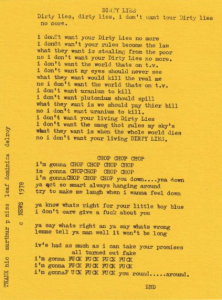
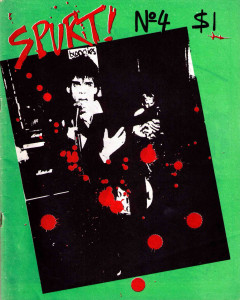
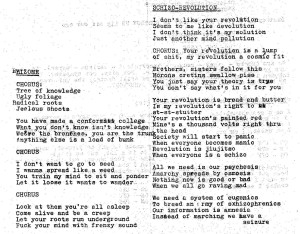
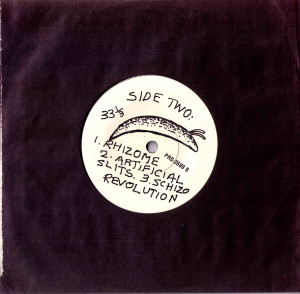
No comments yet.